Art Therapy Effectiveness: Managing Academic Stress in High School
VerifiedAdded on 2023/04/21
|24
|5836
|393
Report
AI Summary
This research proposal investigates the effectiveness of art therapy as an intervention for managing academic stress among secondary school students. It reviews existing literature highlighting the sources and consequences of academic stress, and explores various intervention methods, noting a gap in research concerning art therapy. The study aims to determine if art therapy can reduce academic stress, improve academic performance, release obstructed emotions, increase enjoyment of school subjects, and change distorted self-interpretations of academic events. The proposal outlines a 12-week school-wide art therapy program called "Coloring Life," designed to teach students to express their emotions creatively and reduce stress. The research emphasizes a whole-school approach involving students, educators, parents, and counselors, and aims to strengthen relationships and promote self-expression through artistic media. The innovative aspect lies in using art therapy, a creative approach, to address academic stress, which has not been extensively studied.
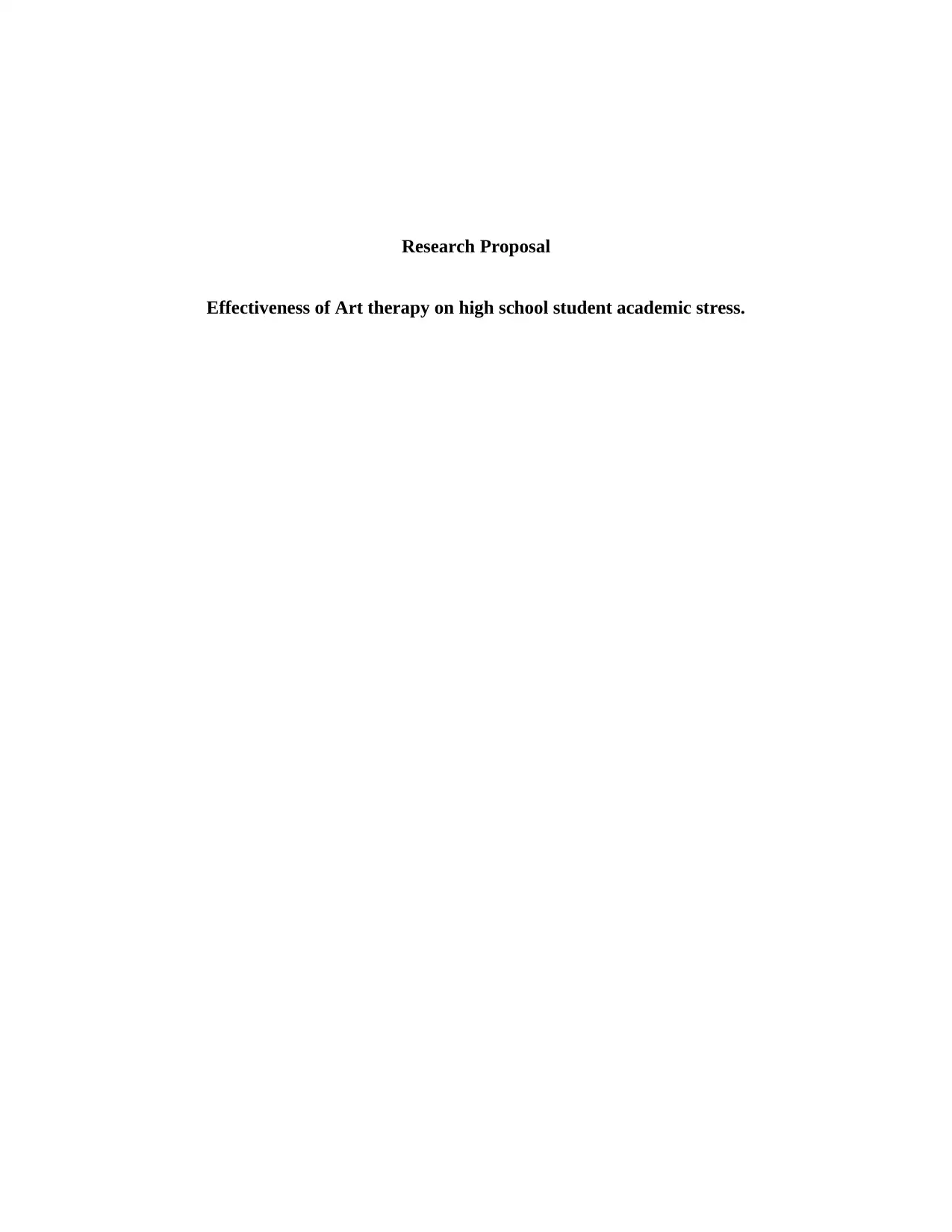
Research Proposal
Effectiveness of Art therapy on high school student academic stress.
Effectiveness of Art therapy on high school student academic stress.
Paraphrase This Document
Need a fresh take? Get an instant paraphrase of this document with our AI Paraphraser
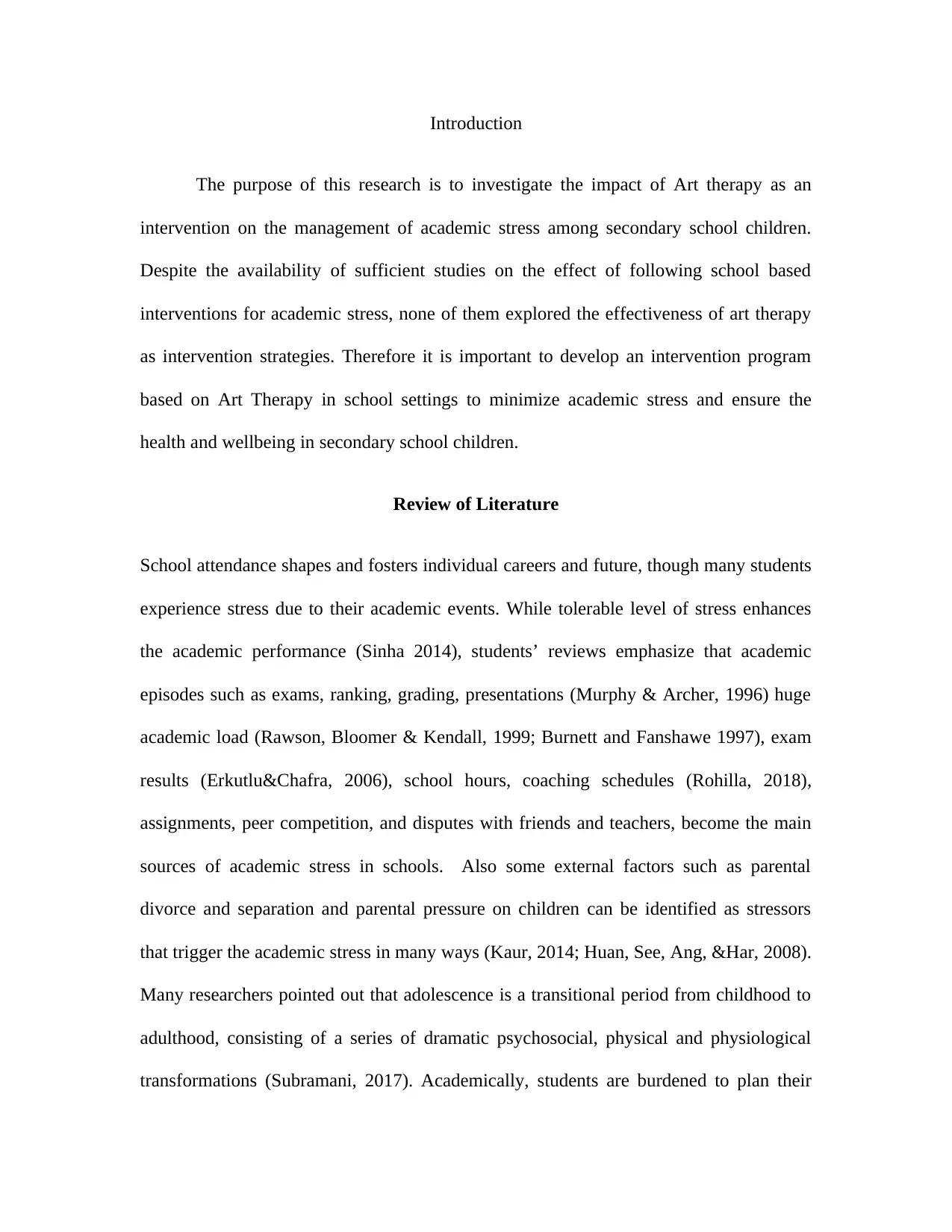
Introduction
The purpose of this research is to investigate the impact of Art therapy as an
intervention on the management of academic stress among secondary school children.
Despite the availability of sufficient studies on the effect of following school based
interventions for academic stress, none of them explored the effectiveness of art therapy
as intervention strategies. Therefore it is important to develop an intervention program
based on Art Therapy in school settings to minimize academic stress and ensure the
health and wellbeing in secondary school children.
Review of Literature
School attendance shapes and fosters individual careers and future, though many students
experience stress due to their academic events. While tolerable level of stress enhances
the academic performance (Sinha 2014), students’ reviews emphasize that academic
episodes such as exams, ranking, grading, presentations (Murphy & Archer, 1996) huge
academic load (Rawson, Bloomer & Kendall, 1999; Burnett and Fanshawe 1997), exam
results (Erkutlu&Chafra, 2006), school hours, coaching schedules (Rohilla, 2018),
assignments, peer competition, and disputes with friends and teachers, become the main
sources of academic stress in schools. Also some external factors such as parental
divorce and separation and parental pressure on children can be identified as stressors
that trigger the academic stress in many ways (Kaur, 2014; Huan, See, Ang, &Har, 2008).
Many researchers pointed out that adolescence is a transitional period from childhood to
adulthood, consisting of a series of dramatic psychosocial, physical and physiological
transformations (Subramani, 2017). Academically, students are burdened to plan their
The purpose of this research is to investigate the impact of Art therapy as an
intervention on the management of academic stress among secondary school children.
Despite the availability of sufficient studies on the effect of following school based
interventions for academic stress, none of them explored the effectiveness of art therapy
as intervention strategies. Therefore it is important to develop an intervention program
based on Art Therapy in school settings to minimize academic stress and ensure the
health and wellbeing in secondary school children.
Review of Literature
School attendance shapes and fosters individual careers and future, though many students
experience stress due to their academic events. While tolerable level of stress enhances
the academic performance (Sinha 2014), students’ reviews emphasize that academic
episodes such as exams, ranking, grading, presentations (Murphy & Archer, 1996) huge
academic load (Rawson, Bloomer & Kendall, 1999; Burnett and Fanshawe 1997), exam
results (Erkutlu&Chafra, 2006), school hours, coaching schedules (Rohilla, 2018),
assignments, peer competition, and disputes with friends and teachers, become the main
sources of academic stress in schools. Also some external factors such as parental
divorce and separation and parental pressure on children can be identified as stressors
that trigger the academic stress in many ways (Kaur, 2014; Huan, See, Ang, &Har, 2008).
Many researchers pointed out that adolescence is a transitional period from childhood to
adulthood, consisting of a series of dramatic psychosocial, physical and physiological
transformations (Subramani, 2017). Academically, students are burdened to plan their
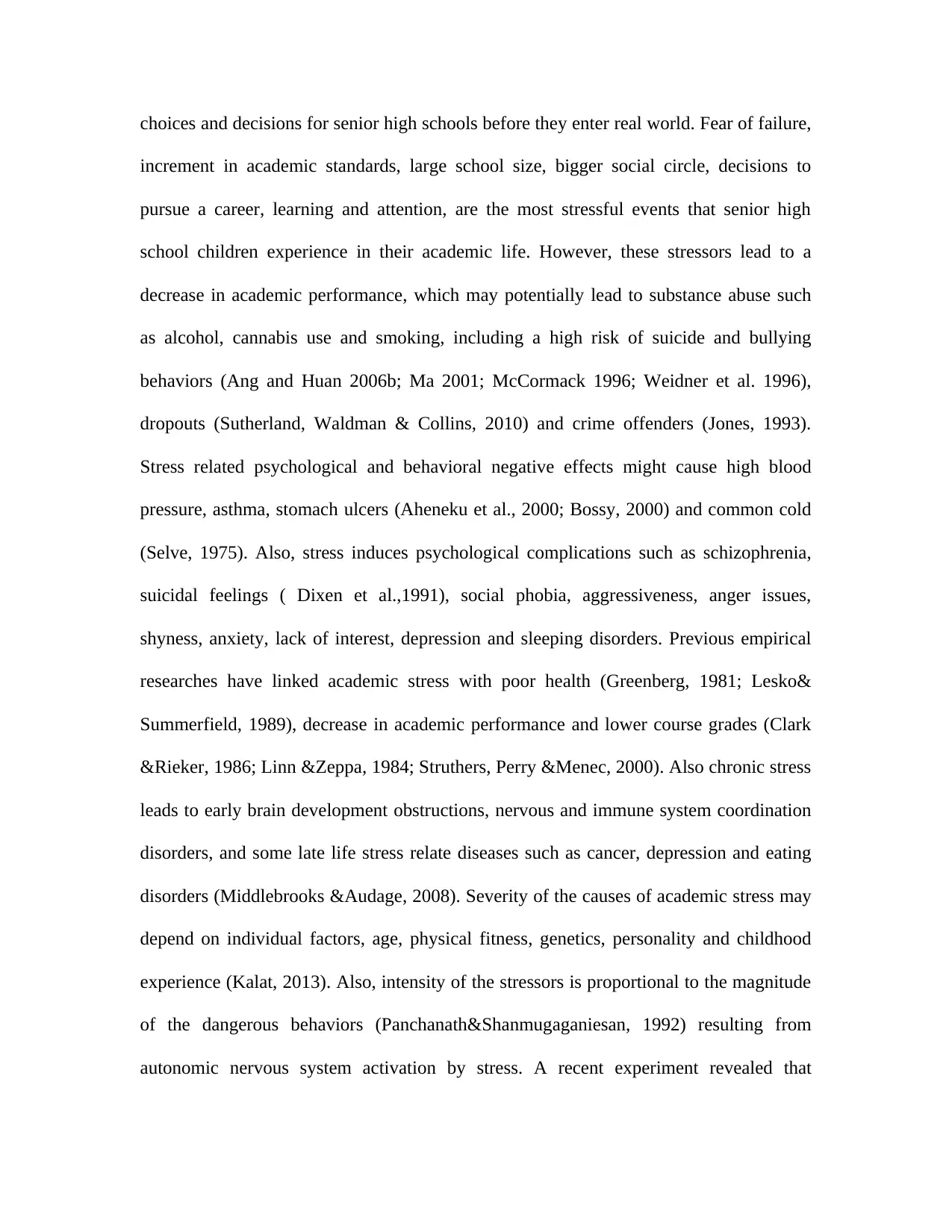
choices and decisions for senior high schools before they enter real world. Fear of failure,
increment in academic standards, large school size, bigger social circle, decisions to
pursue a career, learning and attention, are the most stressful events that senior high
school children experience in their academic life. However, these stressors lead to a
decrease in academic performance, which may potentially lead to substance abuse such
as alcohol, cannabis use and smoking, including a high risk of suicide and bullying
behaviors (Ang and Huan 2006b; Ma 2001; McCormack 1996; Weidner et al. 1996),
dropouts (Sutherland, Waldman & Collins, 2010) and crime offenders (Jones, 1993).
Stress related psychological and behavioral negative effects might cause high blood
pressure, asthma, stomach ulcers (Aheneku et al., 2000; Bossy, 2000) and common cold
(Selve, 1975). Also, stress induces psychological complications such as schizophrenia,
suicidal feelings ( Dixen et al.,1991), social phobia, aggressiveness, anger issues,
shyness, anxiety, lack of interest, depression and sleeping disorders. Previous empirical
researches have linked academic stress with poor health (Greenberg, 1981; Lesko&
Summerfield, 1989), decrease in academic performance and lower course grades (Clark
&Rieker, 1986; Linn &Zeppa, 1984; Struthers, Perry &Menec, 2000). Also chronic stress
leads to early brain development obstructions, nervous and immune system coordination
disorders, and some late life stress relate diseases such as cancer, depression and eating
disorders (Middlebrooks &Audage, 2008). Severity of the causes of academic stress may
depend on individual factors, age, physical fitness, genetics, personality and childhood
experience (Kalat, 2013). Also, intensity of the stressors is proportional to the magnitude
of the dangerous behaviors (Panchanath&Shanmugaganiesan, 1992) resulting from
autonomic nervous system activation by stress. A recent experiment revealed that
increment in academic standards, large school size, bigger social circle, decisions to
pursue a career, learning and attention, are the most stressful events that senior high
school children experience in their academic life. However, these stressors lead to a
decrease in academic performance, which may potentially lead to substance abuse such
as alcohol, cannabis use and smoking, including a high risk of suicide and bullying
behaviors (Ang and Huan 2006b; Ma 2001; McCormack 1996; Weidner et al. 1996),
dropouts (Sutherland, Waldman & Collins, 2010) and crime offenders (Jones, 1993).
Stress related psychological and behavioral negative effects might cause high blood
pressure, asthma, stomach ulcers (Aheneku et al., 2000; Bossy, 2000) and common cold
(Selve, 1975). Also, stress induces psychological complications such as schizophrenia,
suicidal feelings ( Dixen et al.,1991), social phobia, aggressiveness, anger issues,
shyness, anxiety, lack of interest, depression and sleeping disorders. Previous empirical
researches have linked academic stress with poor health (Greenberg, 1981; Lesko&
Summerfield, 1989), decrease in academic performance and lower course grades (Clark
&Rieker, 1986; Linn &Zeppa, 1984; Struthers, Perry &Menec, 2000). Also chronic stress
leads to early brain development obstructions, nervous and immune system coordination
disorders, and some late life stress relate diseases such as cancer, depression and eating
disorders (Middlebrooks &Audage, 2008). Severity of the causes of academic stress may
depend on individual factors, age, physical fitness, genetics, personality and childhood
experience (Kalat, 2013). Also, intensity of the stressors is proportional to the magnitude
of the dangerous behaviors (Panchanath&Shanmugaganiesan, 1992) resulting from
autonomic nervous system activation by stress. A recent experiment revealed that
⊘ This is a preview!⊘
Do you want full access?
Subscribe today to unlock all pages.

Trusted by 1+ million students worldwide
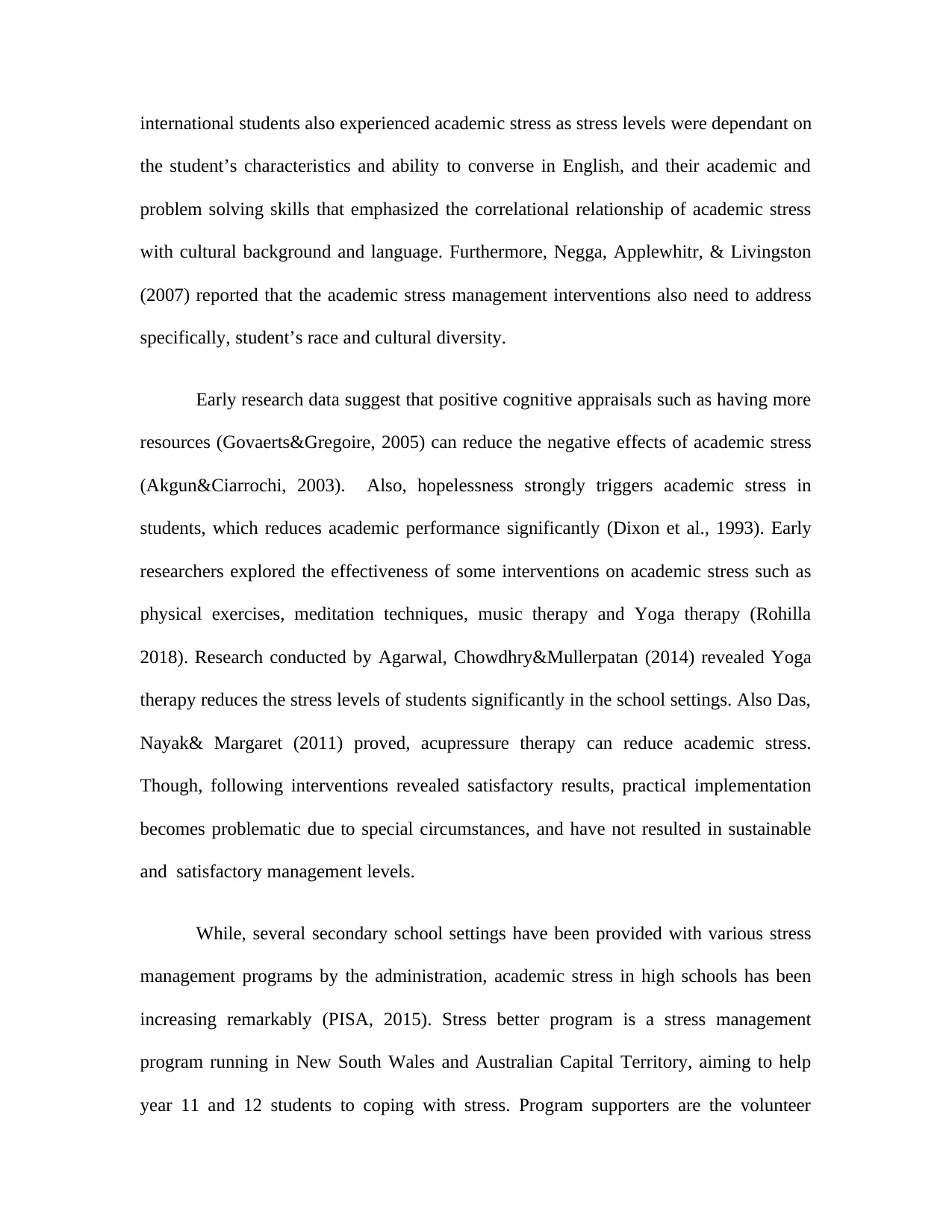
international students also experienced academic stress as stress levels were dependant on
the student’s characteristics and ability to converse in English, and their academic and
problem solving skills that emphasized the correlational relationship of academic stress
with cultural background and language. Furthermore, Negga, Applewhitr, & Livingston
(2007) reported that the academic stress management interventions also need to address
specifically, student’s race and cultural diversity.
Early research data suggest that positive cognitive appraisals such as having more
resources (Govaerts&Gregoire, 2005) can reduce the negative effects of academic stress
(Akgun&Ciarrochi, 2003). Also, hopelessness strongly triggers academic stress in
students, which reduces academic performance significantly (Dixon et al., 1993). Early
researchers explored the effectiveness of some interventions on academic stress such as
physical exercises, meditation techniques, music therapy and Yoga therapy (Rohilla
2018). Research conducted by Agarwal, Chowdhry&Mullerpatan (2014) revealed Yoga
therapy reduces the stress levels of students significantly in the school settings. Also Das,
Nayak& Margaret (2011) proved, acupressure therapy can reduce academic stress.
Though, following interventions revealed satisfactory results, practical implementation
becomes problematic due to special circumstances, and have not resulted in sustainable
and satisfactory management levels.
While, several secondary school settings have been provided with various stress
management programs by the administration, academic stress in high schools has been
increasing remarkably (PISA, 2015). Stress better program is a stress management
program running in New South Wales and Australian Capital Territory, aiming to help
year 11 and 12 students to coping with stress. Program supporters are the volunteer
the student’s characteristics and ability to converse in English, and their academic and
problem solving skills that emphasized the correlational relationship of academic stress
with cultural background and language. Furthermore, Negga, Applewhitr, & Livingston
(2007) reported that the academic stress management interventions also need to address
specifically, student’s race and cultural diversity.
Early research data suggest that positive cognitive appraisals such as having more
resources (Govaerts&Gregoire, 2005) can reduce the negative effects of academic stress
(Akgun&Ciarrochi, 2003). Also, hopelessness strongly triggers academic stress in
students, which reduces academic performance significantly (Dixon et al., 1993). Early
researchers explored the effectiveness of some interventions on academic stress such as
physical exercises, meditation techniques, music therapy and Yoga therapy (Rohilla
2018). Research conducted by Agarwal, Chowdhry&Mullerpatan (2014) revealed Yoga
therapy reduces the stress levels of students significantly in the school settings. Also Das,
Nayak& Margaret (2011) proved, acupressure therapy can reduce academic stress.
Though, following interventions revealed satisfactory results, practical implementation
becomes problematic due to special circumstances, and have not resulted in sustainable
and satisfactory management levels.
While, several secondary school settings have been provided with various stress
management programs by the administration, academic stress in high schools has been
increasing remarkably (PISA, 2015). Stress better program is a stress management
program running in New South Wales and Australian Capital Territory, aiming to help
year 11 and 12 students to coping with stress. Program supporters are the volunteer
Paraphrase This Document
Need a fresh take? Get an instant paraphrase of this document with our AI Paraphraser
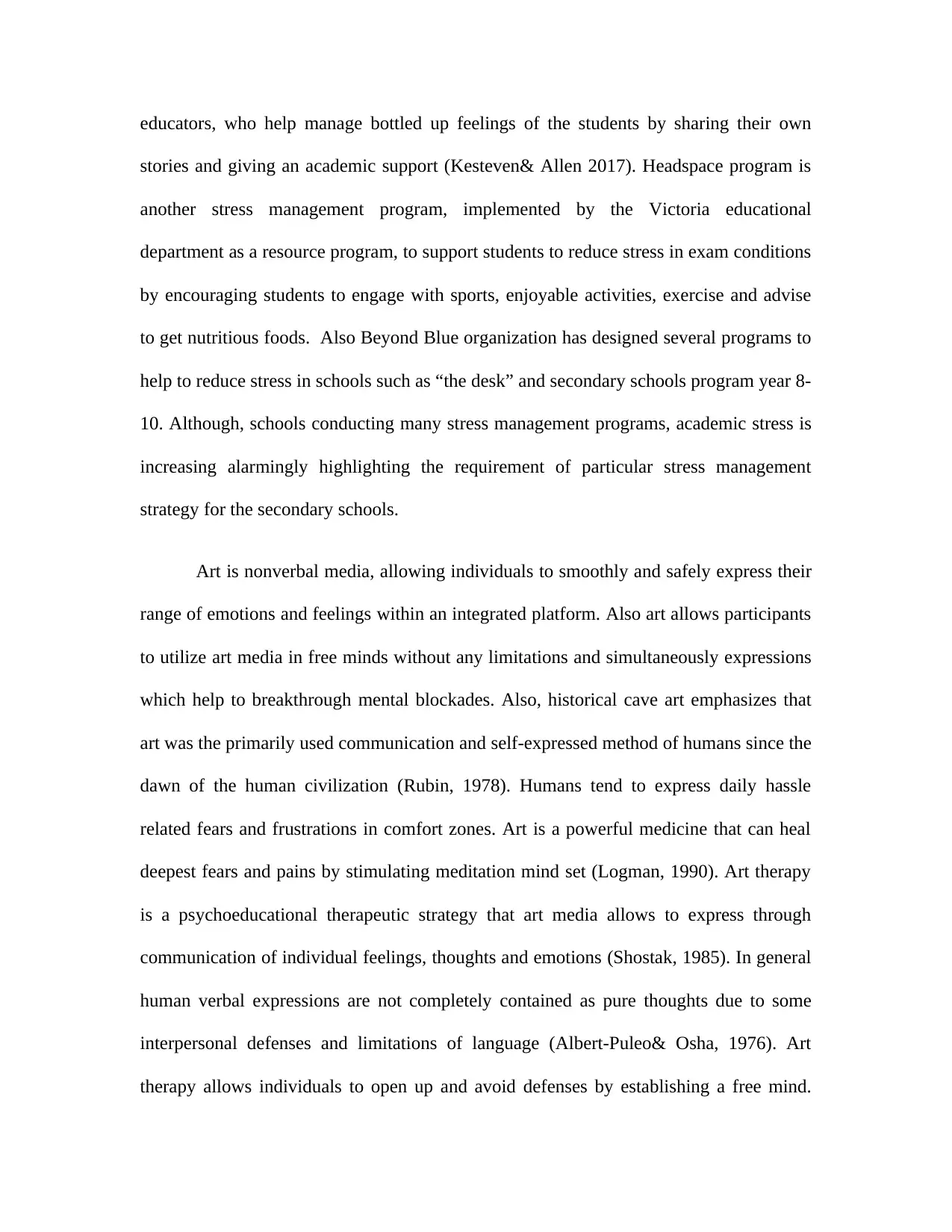
educators, who help manage bottled up feelings of the students by sharing their own
stories and giving an academic support (Kesteven& Allen 2017). Headspace program is
another stress management program, implemented by the Victoria educational
department as a resource program, to support students to reduce stress in exam conditions
by encouraging students to engage with sports, enjoyable activities, exercise and advise
to get nutritious foods. Also Beyond Blue organization has designed several programs to
help to reduce stress in schools such as “the desk” and secondary schools program year 8-
10. Although, schools conducting many stress management programs, academic stress is
increasing alarmingly highlighting the requirement of particular stress management
strategy for the secondary schools.
Art is nonverbal media, allowing individuals to smoothly and safely express their
range of emotions and feelings within an integrated platform. Also art allows participants
to utilize art media in free minds without any limitations and simultaneously expressions
which help to breakthrough mental blockades. Also, historical cave art emphasizes that
art was the primarily used communication and self-expressed method of humans since the
dawn of the human civilization (Rubin, 1978). Humans tend to express daily hassle
related fears and frustrations in comfort zones. Art is a powerful medicine that can heal
deepest fears and pains by stimulating meditation mind set (Logman, 1990). Art therapy
is a psychoeducational therapeutic strategy that art media allows to express through
communication of individual feelings, thoughts and emotions (Shostak, 1985). In general
human verbal expressions are not completely contained as pure thoughts due to some
interpersonal defenses and limitations of language (Albert-Puleo& Osha, 1976). Art
therapy allows individuals to open up and avoid defenses by establishing a free mind.
stories and giving an academic support (Kesteven& Allen 2017). Headspace program is
another stress management program, implemented by the Victoria educational
department as a resource program, to support students to reduce stress in exam conditions
by encouraging students to engage with sports, enjoyable activities, exercise and advise
to get nutritious foods. Also Beyond Blue organization has designed several programs to
help to reduce stress in schools such as “the desk” and secondary schools program year 8-
10. Although, schools conducting many stress management programs, academic stress is
increasing alarmingly highlighting the requirement of particular stress management
strategy for the secondary schools.
Art is nonverbal media, allowing individuals to smoothly and safely express their
range of emotions and feelings within an integrated platform. Also art allows participants
to utilize art media in free minds without any limitations and simultaneously expressions
which help to breakthrough mental blockades. Also, historical cave art emphasizes that
art was the primarily used communication and self-expressed method of humans since the
dawn of the human civilization (Rubin, 1978). Humans tend to express daily hassle
related fears and frustrations in comfort zones. Art is a powerful medicine that can heal
deepest fears and pains by stimulating meditation mind set (Logman, 1990). Art therapy
is a psychoeducational therapeutic strategy that art media allows to express through
communication of individual feelings, thoughts and emotions (Shostak, 1985). In general
human verbal expressions are not completely contained as pure thoughts due to some
interpersonal defenses and limitations of language (Albert-Puleo& Osha, 1976). Art
therapy allows individuals to open up and avoid defenses by establishing a free mind.
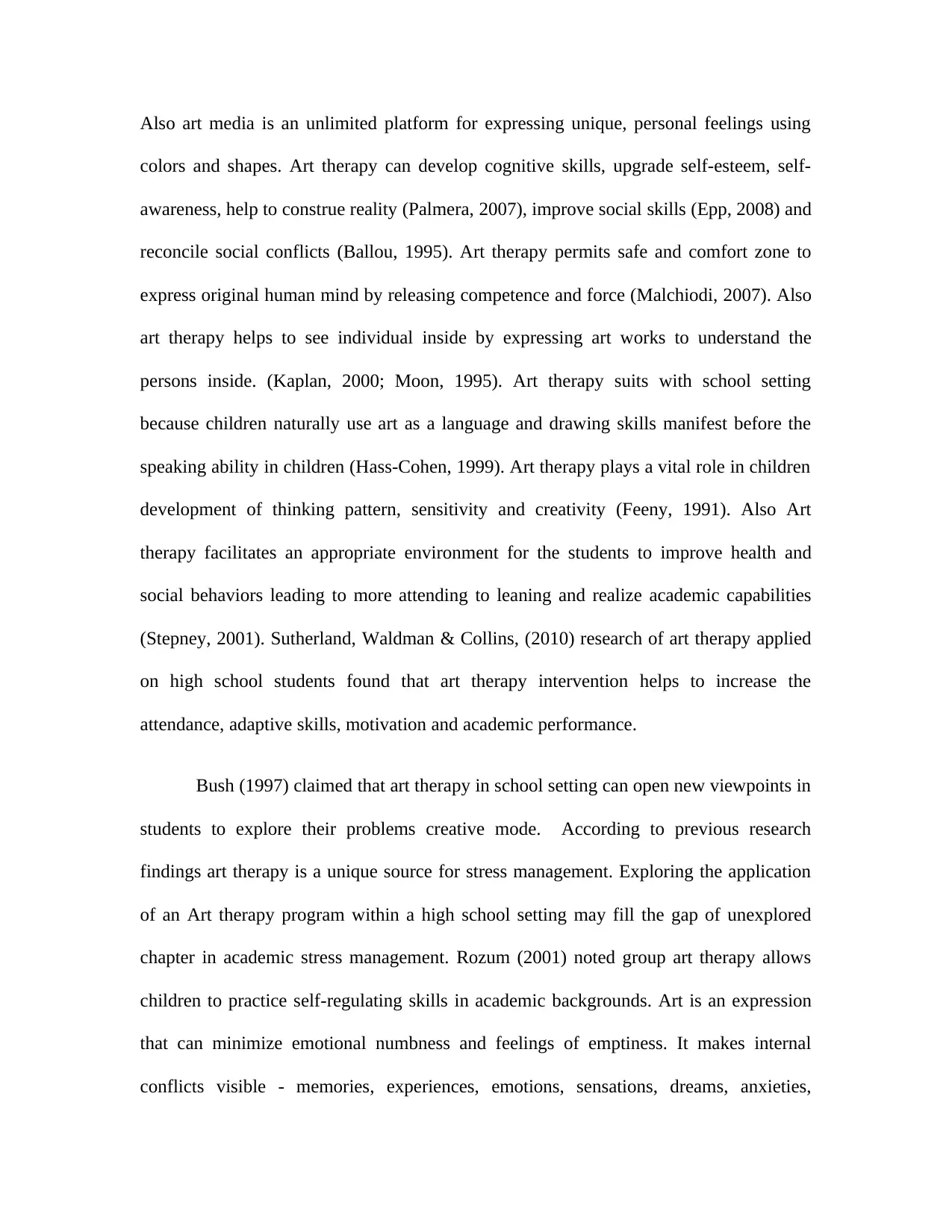
Also art media is an unlimited platform for expressing unique, personal feelings using
colors and shapes. Art therapy can develop cognitive skills, upgrade self-esteem, self-
awareness, help to construe reality (Palmera, 2007), improve social skills (Epp, 2008) and
reconcile social conflicts (Ballou, 1995). Art therapy permits safe and comfort zone to
express original human mind by releasing competence and force (Malchiodi, 2007). Also
art therapy helps to see individual inside by expressing art works to understand the
persons inside. (Kaplan, 2000; Moon, 1995). Art therapy suits with school setting
because children naturally use art as a language and drawing skills manifest before the
speaking ability in children (Hass-Cohen, 1999). Art therapy plays a vital role in children
development of thinking pattern, sensitivity and creativity (Feeny, 1991). Also Art
therapy facilitates an appropriate environment for the students to improve health and
social behaviors leading to more attending to leaning and realize academic capabilities
(Stepney, 2001). Sutherland, Waldman & Collins, (2010) research of art therapy applied
on high school students found that art therapy intervention helps to increase the
attendance, adaptive skills, motivation and academic performance.
Bush (1997) claimed that art therapy in school setting can open new viewpoints in
students to explore their problems creative mode. According to previous research
findings art therapy is a unique source for stress management. Exploring the application
of an Art therapy program within a high school setting may fill the gap of unexplored
chapter in academic stress management. Rozum (2001) noted group art therapy allows
children to practice self-regulating skills in academic backgrounds. Art is an expression
that can minimize emotional numbness and feelings of emptiness. It makes internal
conflicts visible - memories, experiences, emotions, sensations, dreams, anxieties,
colors and shapes. Art therapy can develop cognitive skills, upgrade self-esteem, self-
awareness, help to construe reality (Palmera, 2007), improve social skills (Epp, 2008) and
reconcile social conflicts (Ballou, 1995). Art therapy permits safe and comfort zone to
express original human mind by releasing competence and force (Malchiodi, 2007). Also
art therapy helps to see individual inside by expressing art works to understand the
persons inside. (Kaplan, 2000; Moon, 1995). Art therapy suits with school setting
because children naturally use art as a language and drawing skills manifest before the
speaking ability in children (Hass-Cohen, 1999). Art therapy plays a vital role in children
development of thinking pattern, sensitivity and creativity (Feeny, 1991). Also Art
therapy facilitates an appropriate environment for the students to improve health and
social behaviors leading to more attending to leaning and realize academic capabilities
(Stepney, 2001). Sutherland, Waldman & Collins, (2010) research of art therapy applied
on high school students found that art therapy intervention helps to increase the
attendance, adaptive skills, motivation and academic performance.
Bush (1997) claimed that art therapy in school setting can open new viewpoints in
students to explore their problems creative mode. According to previous research
findings art therapy is a unique source for stress management. Exploring the application
of an Art therapy program within a high school setting may fill the gap of unexplored
chapter in academic stress management. Rozum (2001) noted group art therapy allows
children to practice self-regulating skills in academic backgrounds. Art is an expression
that can minimize emotional numbness and feelings of emptiness. It makes internal
conflicts visible - memories, experiences, emotions, sensations, dreams, anxieties,
⊘ This is a preview!⊘
Do you want full access?
Subscribe today to unlock all pages.

Trusted by 1+ million students worldwide
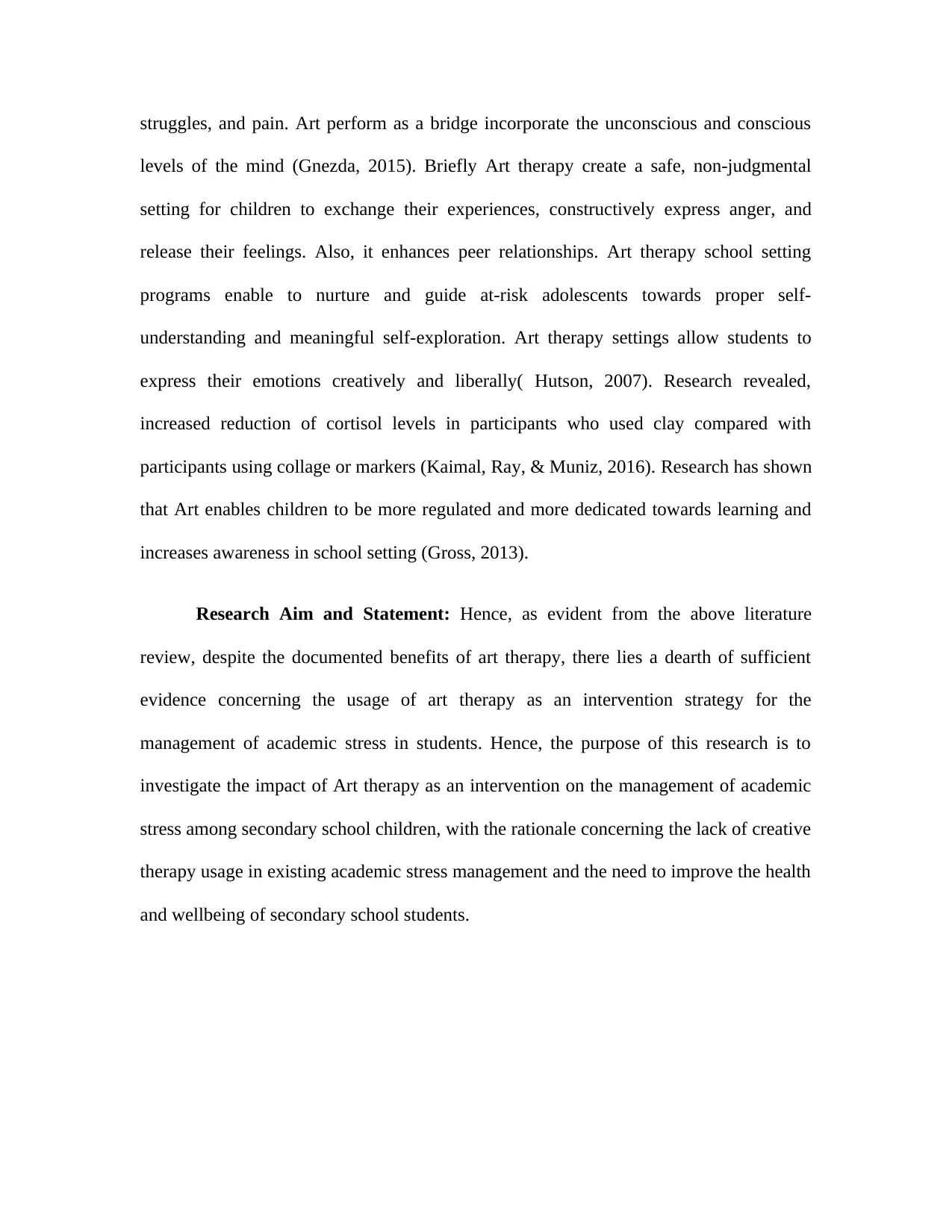
struggles, and pain. Art perform as a bridge incorporate the unconscious and conscious
levels of the mind (Gnezda, 2015). Briefly Art therapy create a safe, non-judgmental
setting for children to exchange their experiences, constructively express anger, and
release their feelings. Also, it enhances peer relationships. Art therapy school setting
programs enable to nurture and guide at-risk adolescents towards proper self-
understanding and meaningful self-exploration. Art therapy settings allow students to
express their emotions creatively and liberally( Hutson, 2007). Research revealed,
increased reduction of cortisol levels in participants who used clay compared with
participants using collage or markers (Kaimal, Ray, & Muniz, 2016). Research has shown
that Art enables children to be more regulated and more dedicated towards learning and
increases awareness in school setting (Gross, 2013).
Research Aim and Statement: Hence, as evident from the above literature
review, despite the documented benefits of art therapy, there lies a dearth of sufficient
evidence concerning the usage of art therapy as an intervention strategy for the
management of academic stress in students. Hence, the purpose of this research is to
investigate the impact of Art therapy as an intervention on the management of academic
stress among secondary school children, with the rationale concerning the lack of creative
therapy usage in existing academic stress management and the need to improve the health
and wellbeing of secondary school students.
levels of the mind (Gnezda, 2015). Briefly Art therapy create a safe, non-judgmental
setting for children to exchange their experiences, constructively express anger, and
release their feelings. Also, it enhances peer relationships. Art therapy school setting
programs enable to nurture and guide at-risk adolescents towards proper self-
understanding and meaningful self-exploration. Art therapy settings allow students to
express their emotions creatively and liberally( Hutson, 2007). Research revealed,
increased reduction of cortisol levels in participants who used clay compared with
participants using collage or markers (Kaimal, Ray, & Muniz, 2016). Research has shown
that Art enables children to be more regulated and more dedicated towards learning and
increases awareness in school setting (Gross, 2013).
Research Aim and Statement: Hence, as evident from the above literature
review, despite the documented benefits of art therapy, there lies a dearth of sufficient
evidence concerning the usage of art therapy as an intervention strategy for the
management of academic stress in students. Hence, the purpose of this research is to
investigate the impact of Art therapy as an intervention on the management of academic
stress among secondary school children, with the rationale concerning the lack of creative
therapy usage in existing academic stress management and the need to improve the health
and wellbeing of secondary school students.
Paraphrase This Document
Need a fresh take? Get an instant paraphrase of this document with our AI Paraphraser
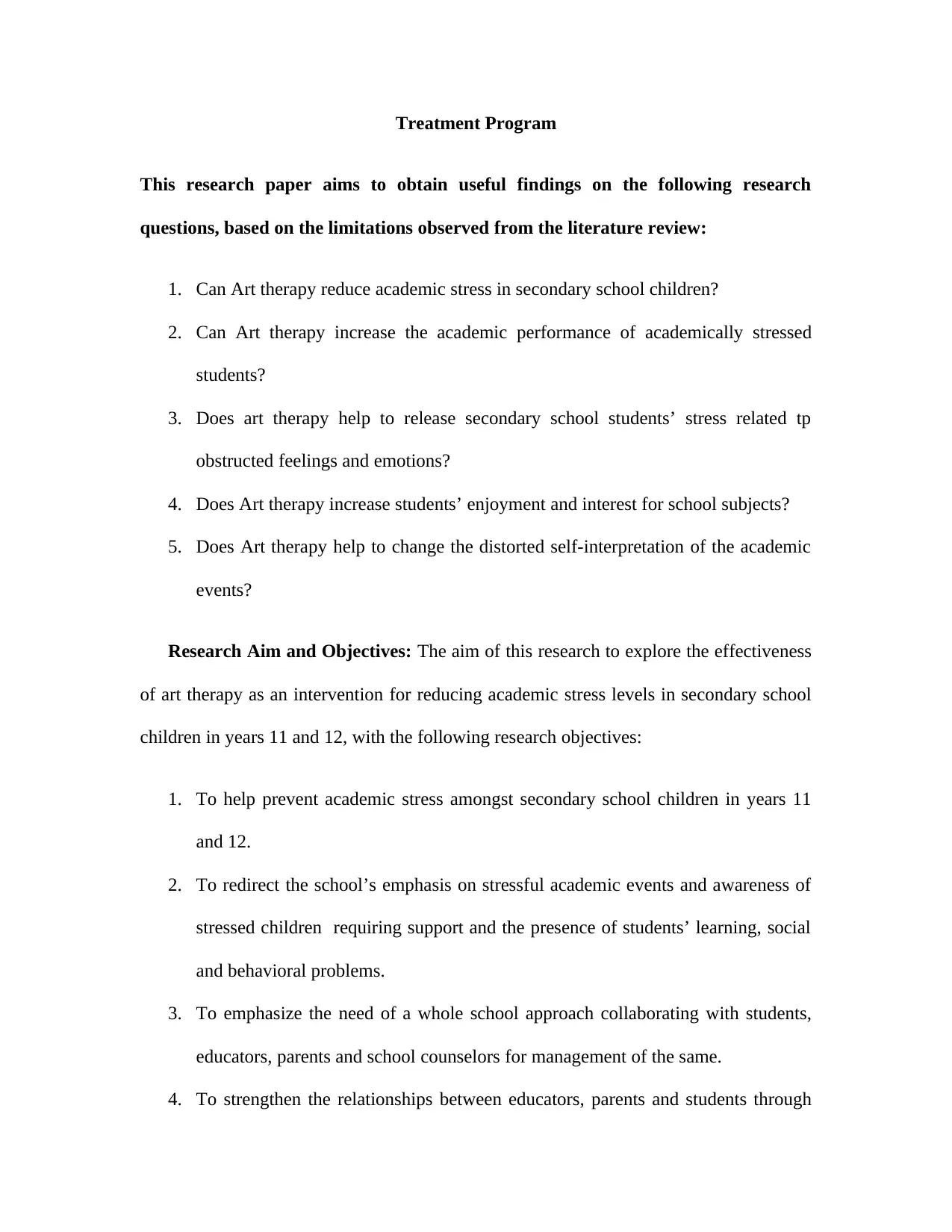
Treatment Program
This research paper aims to obtain useful findings on the following research
questions, based on the limitations observed from the literature review:
1. Can Art therapy reduce academic stress in secondary school children?
2. Can Art therapy increase the academic performance of academically stressed
students?
3. Does art therapy help to release secondary school students’ stress related tp
obstructed feelings and emotions?
4. Does Art therapy increase students’ enjoyment and interest for school subjects?
5. Does Art therapy help to change the distorted self-interpretation of the academic
events?
Research Aim and Objectives: The aim of this research to explore the effectiveness
of art therapy as an intervention for reducing academic stress levels in secondary school
children in years 11 and 12, with the following research objectives:
1. To help prevent academic stress amongst secondary school children in years 11
and 12.
2. To redirect the school’s emphasis on stressful academic events and awareness of
stressed children requiring support and the presence of students’ learning, social
and behavioral problems.
3. To emphasize the need of a whole school approach collaborating with students,
educators, parents and school counselors for management of the same.
4. To strengthen the relationships between educators, parents and students through
This research paper aims to obtain useful findings on the following research
questions, based on the limitations observed from the literature review:
1. Can Art therapy reduce academic stress in secondary school children?
2. Can Art therapy increase the academic performance of academically stressed
students?
3. Does art therapy help to release secondary school students’ stress related tp
obstructed feelings and emotions?
4. Does Art therapy increase students’ enjoyment and interest for school subjects?
5. Does Art therapy help to change the distorted self-interpretation of the academic
events?
Research Aim and Objectives: The aim of this research to explore the effectiveness
of art therapy as an intervention for reducing academic stress levels in secondary school
children in years 11 and 12, with the following research objectives:
1. To help prevent academic stress amongst secondary school children in years 11
and 12.
2. To redirect the school’s emphasis on stressful academic events and awareness of
stressed children requiring support and the presence of students’ learning, social
and behavioral problems.
3. To emphasize the need of a whole school approach collaborating with students,
educators, parents and school counselors for management of the same.
4. To strengthen the relationships between educators, parents and students through
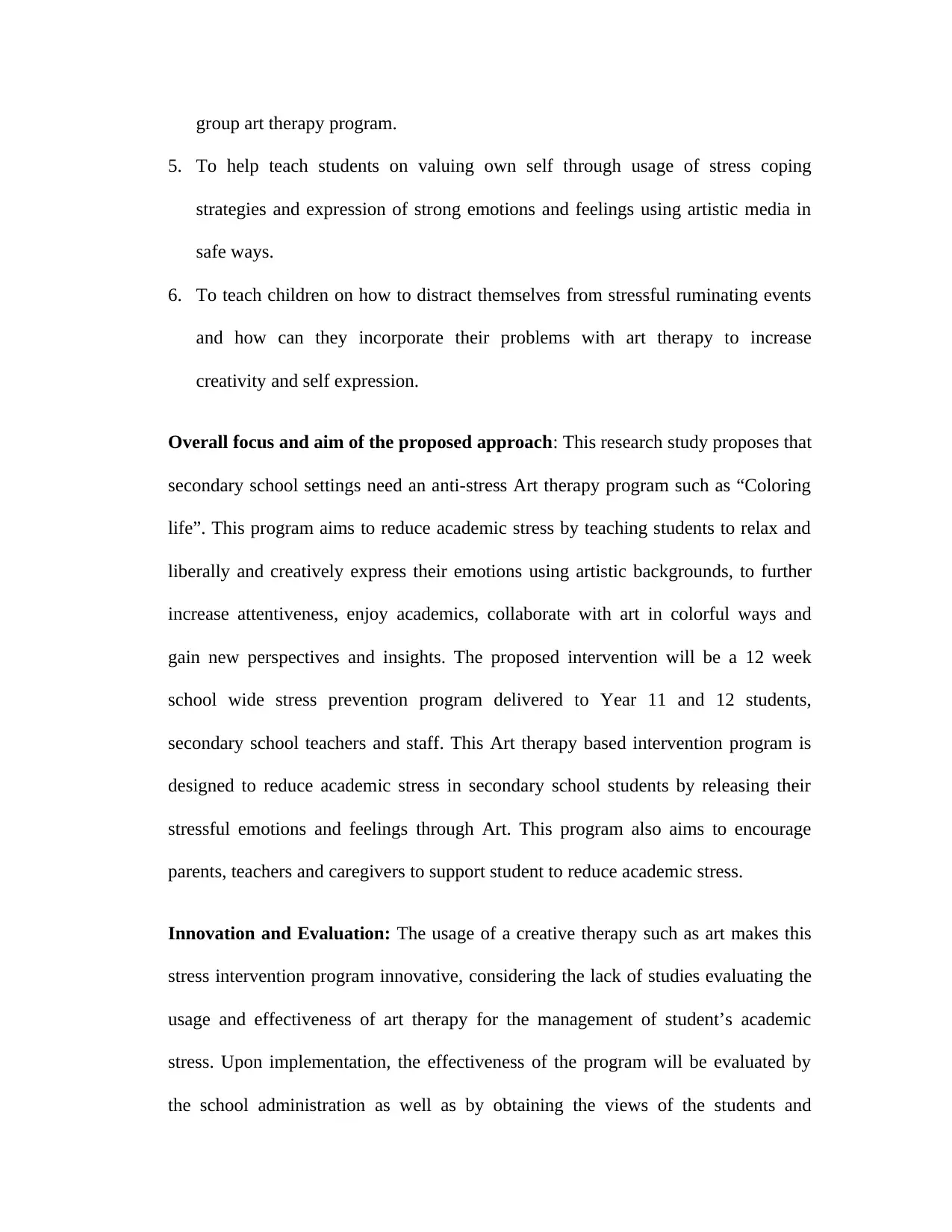
group art therapy program.
5. To help teach students on valuing own self through usage of stress coping
strategies and expression of strong emotions and feelings using artistic media in
safe ways.
6. To teach children on how to distract themselves from stressful ruminating events
and how can they incorporate their problems with art therapy to increase
creativity and self expression.
Overall focus and aim of the proposed approach: This research study proposes that
secondary school settings need an anti-stress Art therapy program such as “Coloring
life”. This program aims to reduce academic stress by teaching students to relax and
liberally and creatively express their emotions using artistic backgrounds, to further
increase attentiveness, enjoy academics, collaborate with art in colorful ways and
gain new perspectives and insights. The proposed intervention will be a 12 week
school wide stress prevention program delivered to Year 11 and 12 students,
secondary school teachers and staff. This Art therapy based intervention program is
designed to reduce academic stress in secondary school students by releasing their
stressful emotions and feelings through Art. This program also aims to encourage
parents, teachers and caregivers to support student to reduce academic stress.
Innovation and Evaluation: The usage of a creative therapy such as art makes this
stress intervention program innovative, considering the lack of studies evaluating the
usage and effectiveness of art therapy for the management of student’s academic
stress. Upon implementation, the effectiveness of the program will be evaluated by
the school administration as well as by obtaining the views of the students and
5. To help teach students on valuing own self through usage of stress coping
strategies and expression of strong emotions and feelings using artistic media in
safe ways.
6. To teach children on how to distract themselves from stressful ruminating events
and how can they incorporate their problems with art therapy to increase
creativity and self expression.
Overall focus and aim of the proposed approach: This research study proposes that
secondary school settings need an anti-stress Art therapy program such as “Coloring
life”. This program aims to reduce academic stress by teaching students to relax and
liberally and creatively express their emotions using artistic backgrounds, to further
increase attentiveness, enjoy academics, collaborate with art in colorful ways and
gain new perspectives and insights. The proposed intervention will be a 12 week
school wide stress prevention program delivered to Year 11 and 12 students,
secondary school teachers and staff. This Art therapy based intervention program is
designed to reduce academic stress in secondary school students by releasing their
stressful emotions and feelings through Art. This program also aims to encourage
parents, teachers and caregivers to support student to reduce academic stress.
Innovation and Evaluation: The usage of a creative therapy such as art makes this
stress intervention program innovative, considering the lack of studies evaluating the
usage and effectiveness of art therapy for the management of student’s academic
stress. Upon implementation, the effectiveness of the program will be evaluated by
the school administration as well as by obtaining the views of the students and
⊘ This is a preview!⊘
Do you want full access?
Subscribe today to unlock all pages.

Trusted by 1+ million students worldwide
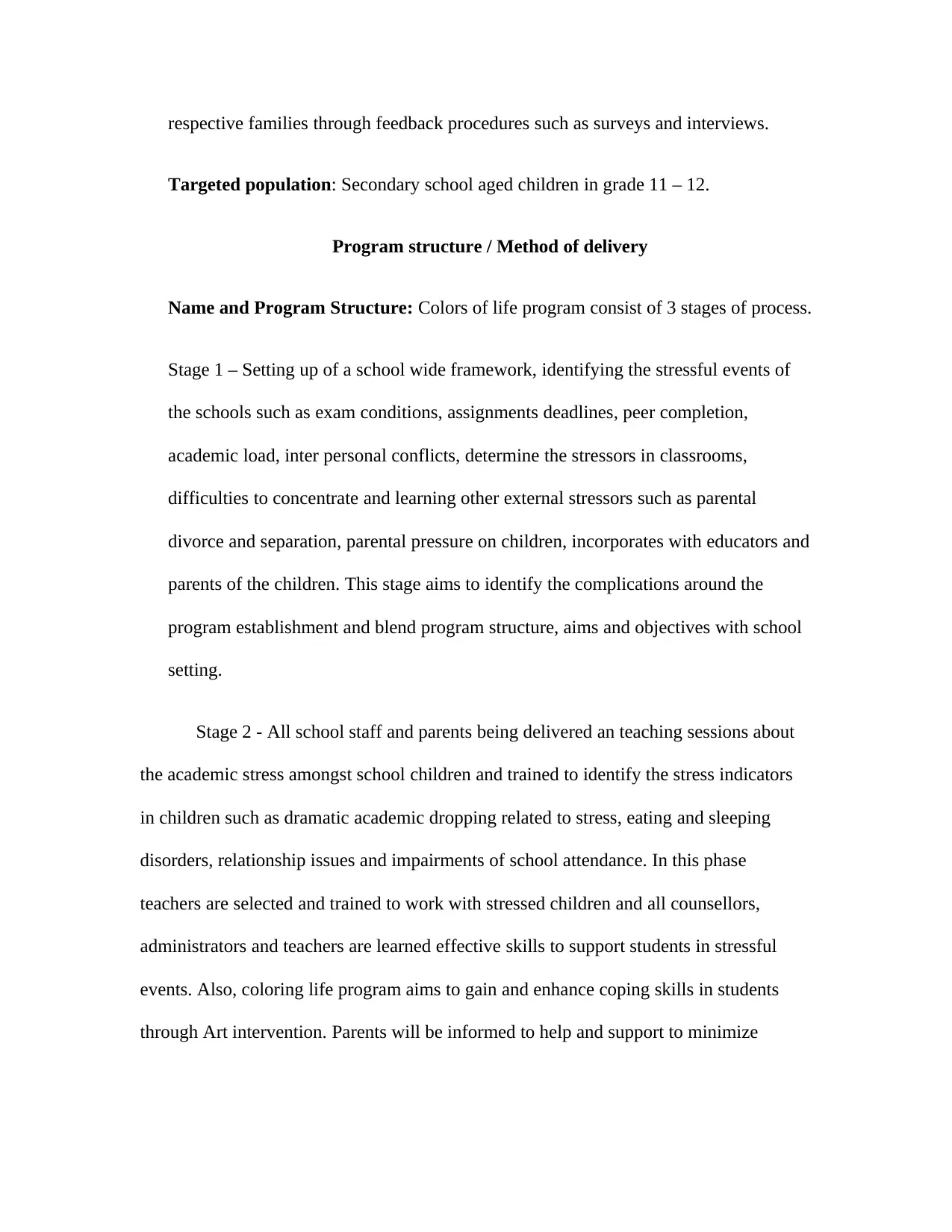
respective families through feedback procedures such as surveys and interviews.
Targeted population: Secondary school aged children in grade 11 – 12.
Program structure / Method of delivery
Name and Program Structure: Colors of life program consist of 3 stages of process.
Stage 1 – Setting up of a school wide framework, identifying the stressful events of
the schools such as exam conditions, assignments deadlines, peer completion,
academic load, inter personal conflicts, determine the stressors in classrooms,
difficulties to concentrate and learning other external stressors such as parental
divorce and separation, parental pressure on children, incorporates with educators and
parents of the children. This stage aims to identify the complications around the
program establishment and blend program structure, aims and objectives with school
setting.
Stage 2 - All school staff and parents being delivered an teaching sessions about
the academic stress amongst school children and trained to identify the stress indicators
in children such as dramatic academic dropping related to stress, eating and sleeping
disorders, relationship issues and impairments of school attendance. In this phase
teachers are selected and trained to work with stressed children and all counsellors,
administrators and teachers are learned effective skills to support students in stressful
events. Also, coloring life program aims to gain and enhance coping skills in students
through Art intervention. Parents will be informed to help and support to minimize
Targeted population: Secondary school aged children in grade 11 – 12.
Program structure / Method of delivery
Name and Program Structure: Colors of life program consist of 3 stages of process.
Stage 1 – Setting up of a school wide framework, identifying the stressful events of
the schools such as exam conditions, assignments deadlines, peer completion,
academic load, inter personal conflicts, determine the stressors in classrooms,
difficulties to concentrate and learning other external stressors such as parental
divorce and separation, parental pressure on children, incorporates with educators and
parents of the children. This stage aims to identify the complications around the
program establishment and blend program structure, aims and objectives with school
setting.
Stage 2 - All school staff and parents being delivered an teaching sessions about
the academic stress amongst school children and trained to identify the stress indicators
in children such as dramatic academic dropping related to stress, eating and sleeping
disorders, relationship issues and impairments of school attendance. In this phase
teachers are selected and trained to work with stressed children and all counsellors,
administrators and teachers are learned effective skills to support students in stressful
events. Also, coloring life program aims to gain and enhance coping skills in students
through Art intervention. Parents will be informed to help and support to minimize
Paraphrase This Document
Need a fresh take? Get an instant paraphrase of this document with our AI Paraphraser
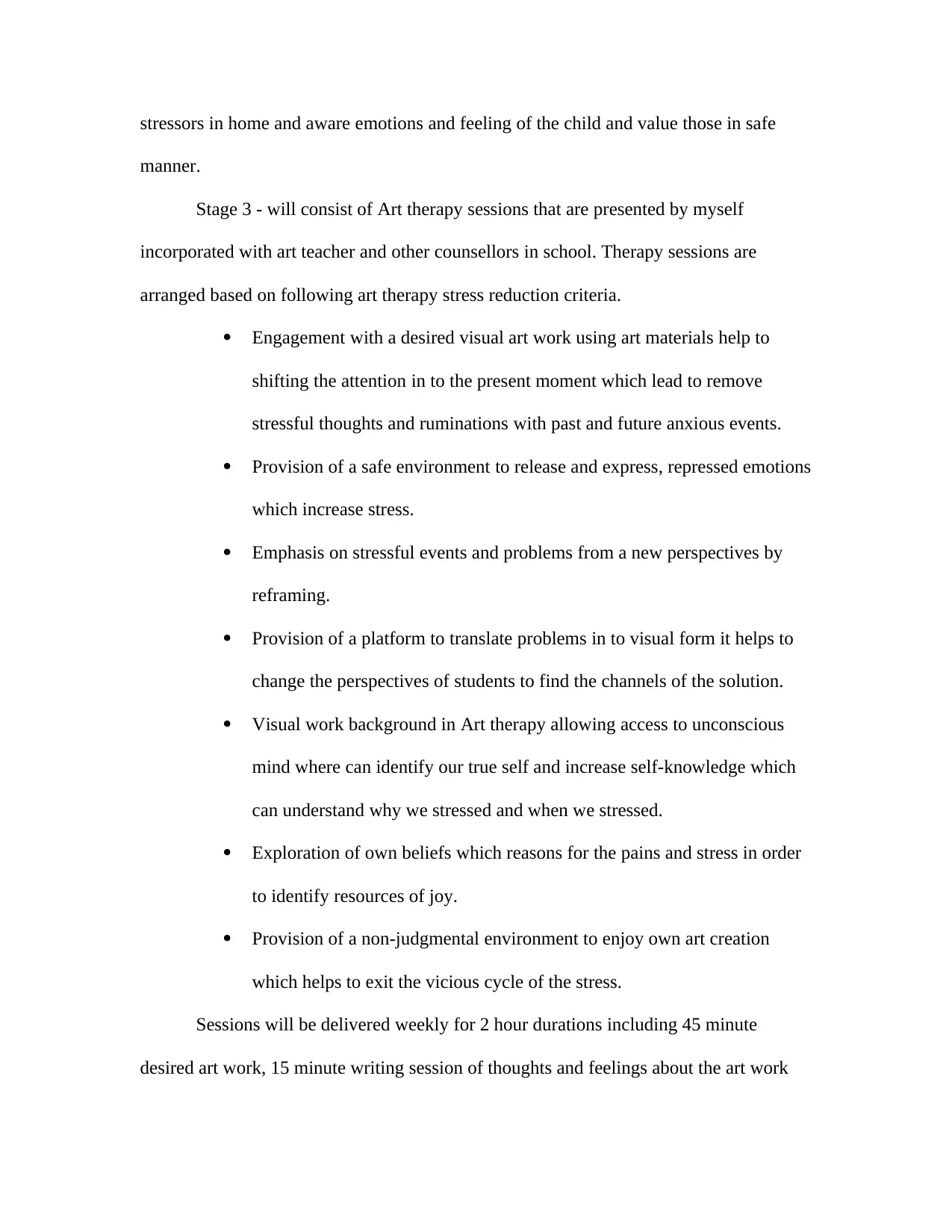
stressors in home and aware emotions and feeling of the child and value those in safe
manner.
Stage 3 - will consist of Art therapy sessions that are presented by myself
incorporated with art teacher and other counsellors in school. Therapy sessions are
arranged based on following art therapy stress reduction criteria.
Engagement with a desired visual art work using art materials help to
shifting the attention in to the present moment which lead to remove
stressful thoughts and ruminations with past and future anxious events.
Provision of a safe environment to release and express, repressed emotions
which increase stress.
Emphasis on stressful events and problems from a new perspectives by
reframing.
Provision of a platform to translate problems in to visual form it helps to
change the perspectives of students to find the channels of the solution.
Visual work background in Art therapy allowing access to unconscious
mind where can identify our true self and increase self-knowledge which
can understand why we stressed and when we stressed.
Exploration of own beliefs which reasons for the pains and stress in order
to identify resources of joy.
Provision of a non-judgmental environment to enjoy own art creation
which helps to exit the vicious cycle of the stress.
Sessions will be delivered weekly for 2 hour durations including 45 minute
desired art work, 15 minute writing session of thoughts and feelings about the art work
manner.
Stage 3 - will consist of Art therapy sessions that are presented by myself
incorporated with art teacher and other counsellors in school. Therapy sessions are
arranged based on following art therapy stress reduction criteria.
Engagement with a desired visual art work using art materials help to
shifting the attention in to the present moment which lead to remove
stressful thoughts and ruminations with past and future anxious events.
Provision of a safe environment to release and express, repressed emotions
which increase stress.
Emphasis on stressful events and problems from a new perspectives by
reframing.
Provision of a platform to translate problems in to visual form it helps to
change the perspectives of students to find the channels of the solution.
Visual work background in Art therapy allowing access to unconscious
mind where can identify our true self and increase self-knowledge which
can understand why we stressed and when we stressed.
Exploration of own beliefs which reasons for the pains and stress in order
to identify resources of joy.
Provision of a non-judgmental environment to enjoy own art creation
which helps to exit the vicious cycle of the stress.
Sessions will be delivered weekly for 2 hour durations including 45 minute
desired art work, 15 minute writing session of thoughts and feelings about the art work
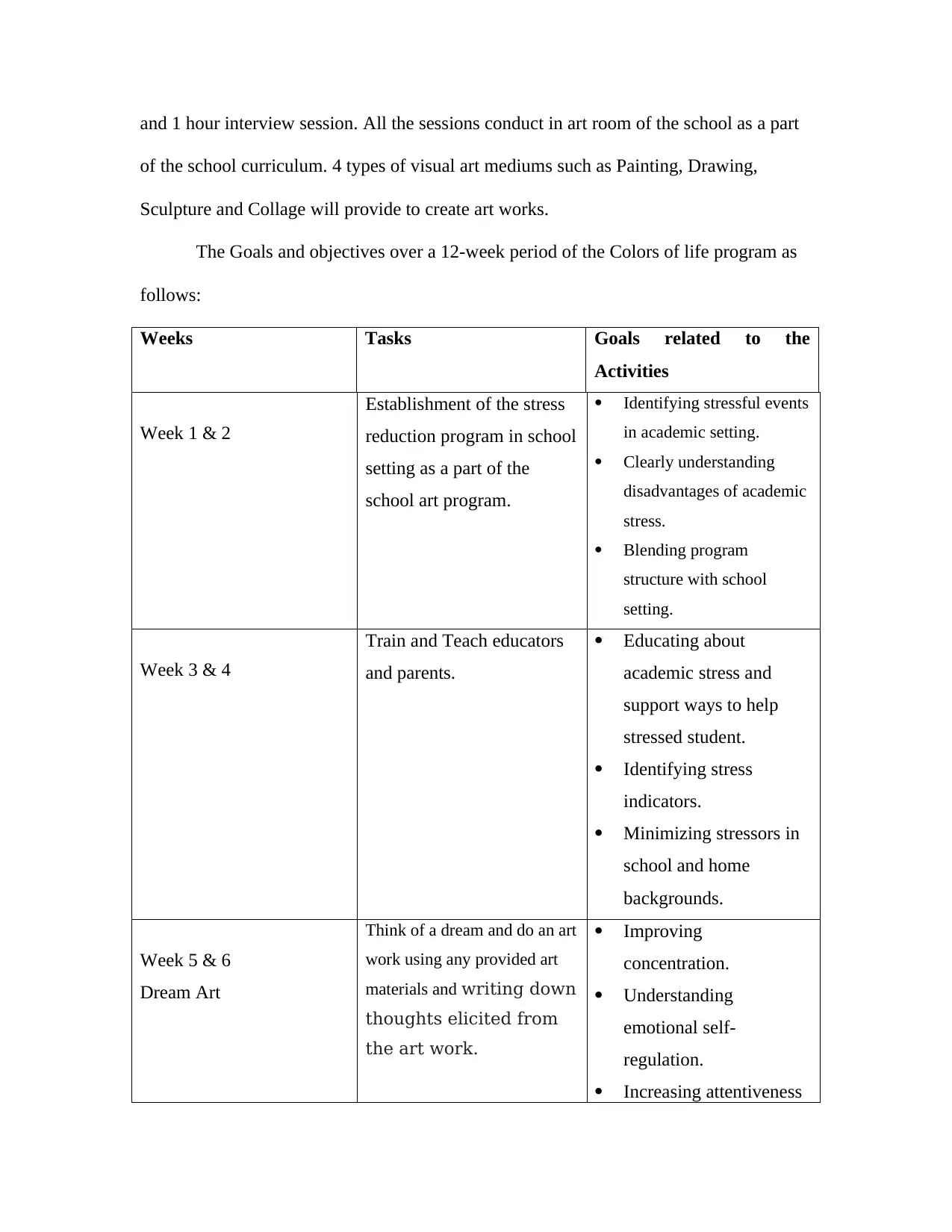
and 1 hour interview session. All the sessions conduct in art room of the school as a part
of the school curriculum. 4 types of visual art mediums such as Painting, Drawing,
Sculpture and Collage will provide to create art works.
The Goals and objectives over a 12-week period of the Colors of life program as
follows:
Weeks Tasks Goals related to the
Activities
Week 1 & 2
Establishment of the stress
reduction program in school
setting as a part of the
school art program.
Identifying stressful events
in academic setting.
Clearly understanding
disadvantages of academic
stress.
Blending program
structure with school
setting.
Week 3 & 4
Train and Teach educators
and parents.
Educating about
academic stress and
support ways to help
stressed student.
Identifying stress
indicators.
Minimizing stressors in
school and home
backgrounds.
Week 5 & 6
Dream Art
Think of a dream and do an art
work using any provided art
materials and writing down
thoughts elicited from
the art work.
Improving
concentration.
Understanding
emotional self-
regulation.
Increasing attentiveness
of the school curriculum. 4 types of visual art mediums such as Painting, Drawing,
Sculpture and Collage will provide to create art works.
The Goals and objectives over a 12-week period of the Colors of life program as
follows:
Weeks Tasks Goals related to the
Activities
Week 1 & 2
Establishment of the stress
reduction program in school
setting as a part of the
school art program.
Identifying stressful events
in academic setting.
Clearly understanding
disadvantages of academic
stress.
Blending program
structure with school
setting.
Week 3 & 4
Train and Teach educators
and parents.
Educating about
academic stress and
support ways to help
stressed student.
Identifying stress
indicators.
Minimizing stressors in
school and home
backgrounds.
Week 5 & 6
Dream Art
Think of a dream and do an art
work using any provided art
materials and writing down
thoughts elicited from
the art work.
Improving
concentration.
Understanding
emotional self-
regulation.
Increasing attentiveness
⊘ This is a preview!⊘
Do you want full access?
Subscribe today to unlock all pages.

Trusted by 1+ million students worldwide
1 out of 24
Your All-in-One AI-Powered Toolkit for Academic Success.
+13062052269
info@desklib.com
Available 24*7 on WhatsApp / Email
![[object Object]](/_next/static/media/star-bottom.7253800d.svg)
Unlock your academic potential
Copyright © 2020–2025 A2Z Services. All Rights Reserved. Developed and managed by ZUCOL.


